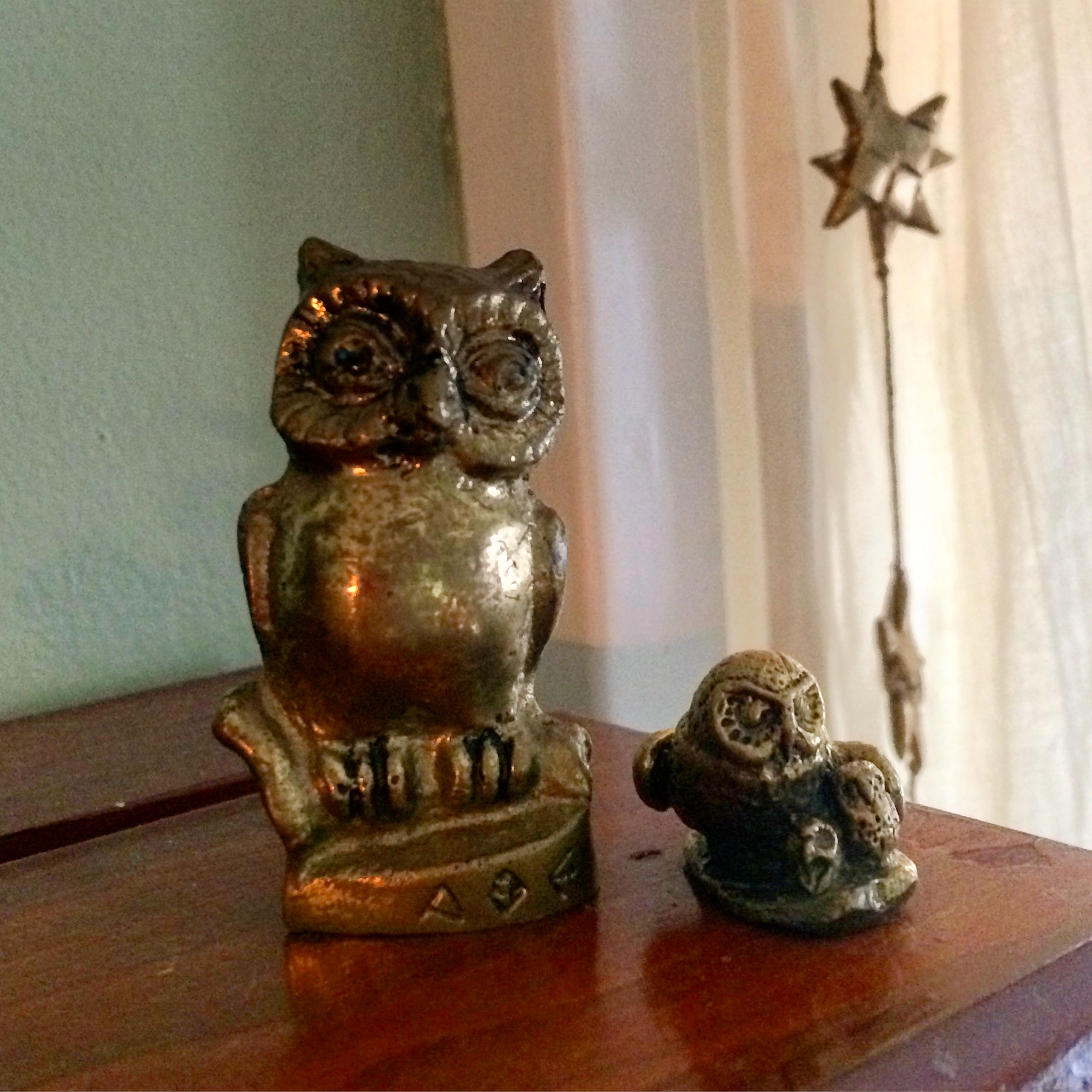Twisted Knickers and Medieval Women
A few years ago, I was asked to give a talk on the dearth of women in the philosophy of religion...which I promptly titled Don't Get Your Panties in a Bunch: the Dilemma of Addressing the Absence of Women in the Philosophy of Religion. (I was going to summarize that paper here, but then I thought to myself, "Self! Isn't this pretty much exactly what blogs are for?" So if you're curious about that earlier piece, see here. On a totally different note, the photo for this post is of the ["Heiliger Grab"]("Heiliger Grab"/Sepulcrum Domini in the Maritiusrotunde (ca. 1260)) (ca. 1260) in Konstanz. It's clearly meant to be Mary 'pondering all these things in her heart,' but I love how it looks like she's tossed Jesus up to the animals so she can have just one minute to herself already.)
This year, I've been asked both to participate in a panel at the Eastern APA showcasing women working in the history of philosophy and to give a paper at the Pacific APA on women in the history of the philosophy of religion. (Women. They're so hot right now.) And now, following up on discussions during his NEH Institute this past summer, Bob Pasnau has asked me to write up a guest post for In medias PHIL on the rather daunting question of how to integrate primary sources by women into courses on medieval philosophy.
Why is this question daunting? Well, for one thing, women were explicitly excluded from studying or holding positions at the universities (and the earlier monastic and cathedral schools), which is where most of what we generally consider 'medieval philosophy' comes from. For another, philosophy and theology are integrally intertwined in the Middle Ages, and women weren't any more welcome in scholarly theological debates than they were in philosophical disputations.
The dearth of medieval women self-consciously engaging in these is so acute, in fact, that I've titled my Pacific APA paper: "Women Didn't DO Philosophy of Religion in the Middle Ages: So Why Am I Still Talking?" Apart from the famous epigram of Julian of Norwich--"All shall be well, and all shall be well, and all manner of thing shall be well"--what else is there to say?
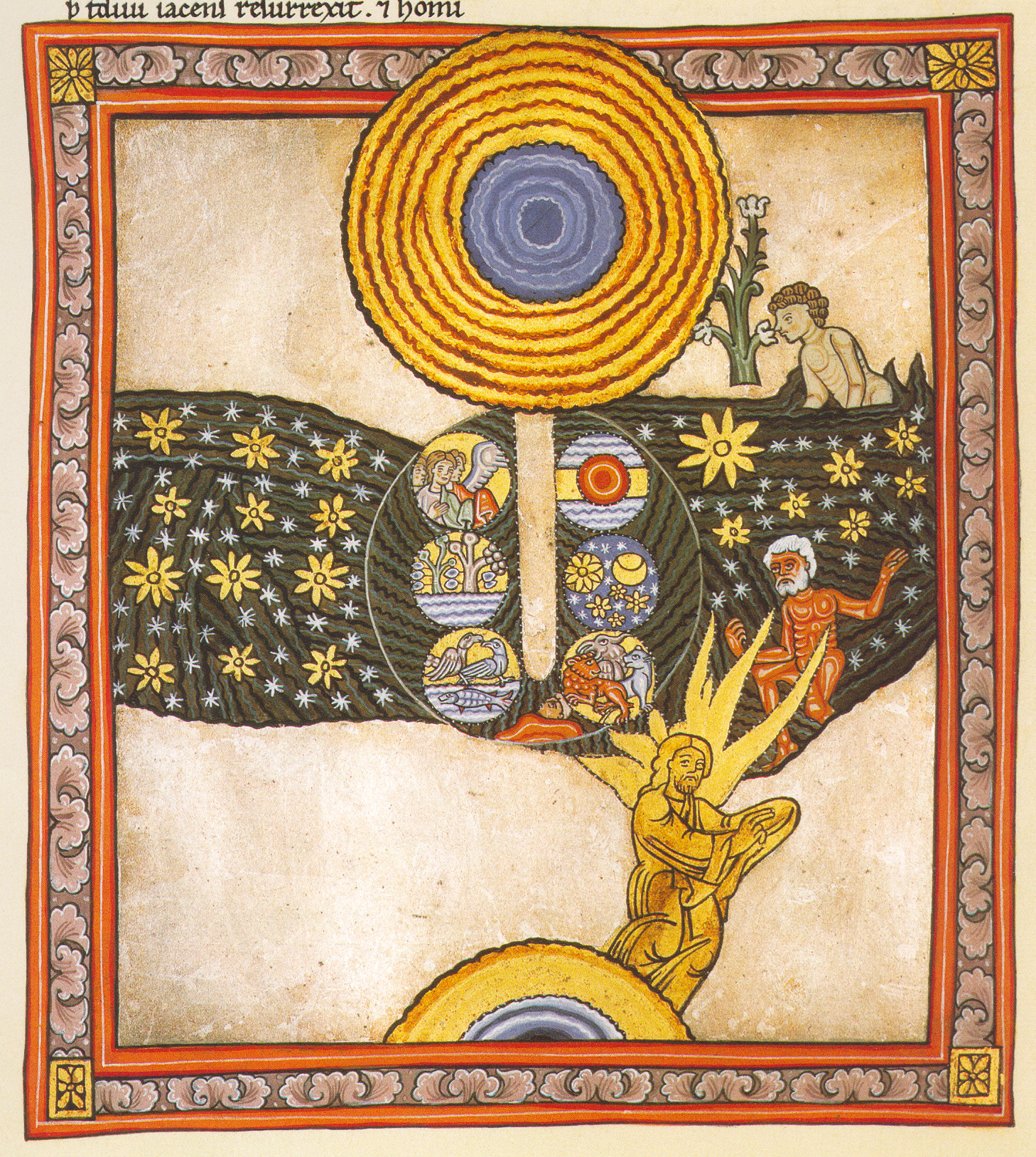
(This is not a picture of Julian of Norwich. This is a detail of an illustration from Hildegard of Bingen called "The Six Days of Creation" that pretty much captures how I feel trying to say meaningful things about this topic...namely, wading into dark, star-filled waters which may or may not contain a bright red, bearded man.)
So, Um, Why Are You Still Talking?
That said, it turns out that I have some fairly strong opinions about (and even some experience with) incorporating primary texts by medieval women into philosophical discussions. In what follows, I'll describe both how and why I've started to address this challenge.
I spent the academic year 2007-8 at CU-Boulder working with Bob Pasnau on the Cambridge History of Medieval Philosophy. (The official editor-approved acronym is CHiMP...the 2nd edition of which is now available in an attractive and affordable two-volume paperback set, with entirely new material in place of the 1.5 chapters originally attributed to Martin Stone. You know, just in case you were wondering what to buy the medieval enthusiast in your midst for the holidays.)
As the chapter drafts started rolling in and we got a sense of how the project as a whole was shaping up, we became aware that virtually none of the entries we were editing discussed women. Bob had worked really hard when soliciting chapters to include the Greek, Islamic, and Jewish traditions as well as the more familiar Latin Christian material, but you could read all 1200+ pages of the medievally goodness in progress and fairly form the impression that women had taken a collective 'pass' on living through the Middle Ages.
This was an unacceptable state of affairs to both of us...but how to address the problem? Adding a chapter on 'Women and Medieval Philosophy' struck us as the worst sort of alienating ad hoc maneuver possible, and adding more mentions of women in the chapters on, say, poverty or religious orders or war didn't exactly address the central issue. Where were women writing in the Middle Ages, and what were they writing about?
As it turns out, the medieval women whose writings have survived through today tend to be mystics and/or contemplatives (especially from the mid-12th through the 15th centuries)--and, as it also turns out, many of the texts these women produced prove both interesting for their relation to ideological and cultural movements and philosophically significant in their own right.
Upon figuring this out, Bob and I decided CHiMP needed a "Mysticism" chapter. After we got turned down by several obvious suspects on the grounds that they didn't know enough about philosophy to do justice to the topic, Bob told me that my joint expertise in 13th century philosophy and gender studies meant that the chapter was all mine.
As I rolled up my sleeves and went to work, I discovered that although female contemplatives in the Middle Ages might not have thought of themselves as engaging in philosophy per se--and although what they wrote often tends not to fit neatly into our contemporary conceptions of even just philosophical theology--if you take a step back and think of philosophy as the love of wisdom, perennially addressing the issues that human beings have wondered about "Since the dawn of time," it turns out that medieval women have a wealth of things to say about classic philosophical debates involving, say, self-knowledge, love, human nature, ethics, God, and the meaning of life.
These women weren't writing in a vacuum, either: they engaged with and influenced intellectual, theological, and cultural movements across (what's now modern-day) Europe. We're not just talking Heloise (who, of course, is best known for her affair with Abelard)--Hildegard of Bingen, Catherine of Sienna, and Julian of Norwich are just a few of the female contemplatives whose advice and counsel were actively sought out by the leading intellectual and ecclesiastical figures of their day.
Cool! So I Can Run Right Out and Add Women Authors to My Medieval Philosophical Discussions/Courses?
Sure! It's easy if you and your students know Middle Low German, Old French, and/or a smattering of Flemish on top of the usual Latin. The fantastic world of mystical philosophical theology is waiting for you like the blazing darkness of the unknowable God!
Ok, fine. It's actually pretty complicated. I don't want to get into the reasons for the obstacles facing the project of incorporating primary texts by women into the medieval mix. Instead, I'm just going to list three of the most significant obstacles, followed by my Suggested Steps of First Response.
Obstacle #1: Courses and current scholarship in medieval philosophy often center more on figures than topics.
Regardless of the other pros and cons of a figure- vs topic-based approach (and there is, of course, a valuable and vigorous debate to be had here), a figures-and-views focus (Anselm's Ontological Argument, Aquinas's Five Ways, Duns Scotus on the Will...) makes it difficult to incorporate new voices into the discussion--especially if those new voices aren't in direct conversation with the Big Names or the conversations they're part of. If you start with Anselm's Ontological Argument, for instance, you can head all sorts of interesting places...but virtually none of them will involve anything written by medieval women.
Suggested Step #1: Try taking a more topical approach--one that focuses on classic Big Questions.
A course on 'Reason and Love,' for instance, would lend itself easily to incorporating awesome stuff from figures such as Hadewijch of Brabant (who both spends a lot of time talking about the nature of love and thinks reason is the best gift God ever gave human beings), Mechtild of Magdeburg (whose Flowing Light of the Godhead is all about love and the human soul), and Julian of Norwich (who has very strong opinions about what love of God and love of fellow human beings should be like, as well as the place of human reason in all this).
Even the more standard 'survey' topics for medieval courses, like 'Intellect and Will' and 'Knowledge (1200-1400)' and 'Happiness in the Middle Ages' offer loads of opportunity for reading people like Marguerite of Porete (who gets burned at the stake in 1310 for her radical views on the will), Hildegard of Bingen (who has thoughts about practically everything, but lots to say in particular about what we know and how we know it), Gertrude the Great (who makes some interesting points about the merits of the active vs. contemplative life), and Catherine of Sienna (who spent a great deal of her short life embroiled in papal politics).
Obstacle #2: Anthologies of medieval philosophy don't tend to include many (if any) women.
Medieval anthologies increasingly include texts by Greek, Jewish, and Islamic philosophers (rather than just Christians from the Latin West), but there are only a handful (if that) which include a significant number of texts by female authors. If you're teaching a basic course on medieval and using any of the standard anthologies, you're probably going to need to do some of your own legwork to bring in even someone as relatively mainstream as Hildegard.
Suggested Step #2: Propose new anthologies and/or edit existing ones to alleviate this issue!
Seriously, people. We need to do this. Jewish and Islamic medieval thought is hardly my speciality, but there's still no world in which I teach a course on medieval at this point without including those traditions. We've all come to realize over the past few decades that it's intellectually irresponsible to ignore what happened outside (modern-day) Europe, especially in the period between Boethius and the rise of the university system. At best, doing so presents a distorted picture of the range of perspectives and approaches to philosophical issues in the Middle Ages. We medievalists are used to arguing against the common belief that ours is an age where intellectual creativity and free thought went to die. The voices of people explicitly excluded from the university system and who were still engaging in radical and original perspectives on central issues constitute more fuel for that fire.
Currently, there's an anthology put out by Pearson that includes some stuff by Hildegard and Catherine of Sienna. In my Ideal World, though, the next edition of all the 'classic' medieval anthologies (Hyman, Walsh, and Williams, Klima, Allhoff, and Vaidya, and Schoedinger, to name a few of the best) would include a number of relevant selections by women.
That means, of course, that we need to start reading more medieval female contemplatives and mystics. (In case it's bugging you, I keep hedging and using both 'contemplative' and 'mystic' for technical reasons that don't really matter here.) Fortunately for those of us who aren't conversant in (say) Middle Low German and who want to survey the territory before diving in more deeply, there are English translations of a great deal of the best stuff. Scholars in English, History, Gender Studies, Religious Studies, and Theology figured out decades ago that there was genuinely important stuff going on in these writings, and so a lot of the hard work of editing primary manuscripts and producing translations has been done.
In the meantime, while we're all waiting for the next editions of these anthologies to come out, it's as good a time as any to do some research to figure out which medieval women touch on your favorite philosophical topics. I will grant you right now that this is going to take some work, and probably some anxiety that this isn't philosophy. Just remember--Anselm's Ontological Argument is part of a prayer, for heaven's sake. The list of people we consider medieval philosophers is already a pretty motley crew by modern standards. That fact is, as far as I'm concerned, one of our subfield's greatest strengths. Broadening the scope of who gets included in that crew gives us more to talk about with people in different fields, as well as deepening our knowledge of the full range of medieval perspectives on philosophical issues.
Obstacle #3: A overwhelming sense of one's own ignorance and finitude.
I am completely uninterested in playing the 'blame-game' of why more people aren't already trying to figure out how work women into their medieval syllabi and scholarship. Let's be blunt. Anyone who's done more than dip a toe into the ocean of medieval philosophy is painfully aware of how much more there is is unknown than known; unedited than edited; untranslated than translated. Scratch the surface of any interesting debate in the 5th-15th centuries and you're also likely to uncover a wealth of material with fascinating connections both to antiquity and to late Renaissance and early-modern thought. It's overwhelming enough merely to attempt doing justice to the medieval figures and debates already on the table, much less to bring in entirely new voices.
In addition, lots of us are already trying to play catch-up with the non-Latin traditions. I will admit straight off, for instance, that my own knowledge of Jewish and Islamic philosophy is embarrassingly narrow. The despairing sense of "Where do I even begin?!" that hits me when I contemplate alleviating that ignorance makes me especially sympathetic to the people who've asked me that question with respect to incorporating medieval texts by women. And so, I give you my final suggestion:
Suggested Step #3: Start with solid secondary literature on the medieval mystics, and let that guide you towards the relevant primary sources.
There is a wealth of excellent secondary literature on medieval mysticism. Because so many of the Christian mystics between 1150 and 1500 were women, pretty much all of that literature deals extensively with female- as well as male- authored texts. A good start is anything written by Caroline Walker Bynum. Fragmentation and Redemption contains some of my favorite essays, but you basically can't go wrong. She has extensive notes and references to primary texts, and she provides detailed and comprehensive treatments of a wide variety of figures over the relevant period. Barbara Newman's God and the Goddesses also incorporates the work of a number of women mystics and contemplatives, as well as stressing the importance of female figures in medieval spirituality. Bernard McGinn is another 'go-to' source for insight into medieval mysticism--and for good reason. His four-volume The Presence of God: A History of Western Christian Mysticism provides excellent historical as well as religious and philosophical background for an examination of this topic.
There are also fantastic books specifically focused on women mystics of the Middle Ages that provide a good sense of the central topics particular figures were concerned with. Amy Hollywood's work is generally strong here (see, e.g., The Soul as Virgin Wife), and Gendered Voices (a collection of essays edited by Caroline Mooney), provides valuably nuanced take on the relation between female mystics and 'their' writings.
Any of these sources--as well as several more I'll mention at the end of this post--would serve as solid starting points for getting a sense of what women authors contributed to philosophical discussions in the Middle Ages.
But I Still Don't Know Anything about These Women!
Not to worry, my friend. Not to worry. As I just mentioned, there are a plethora of resources out there, although it's true that very few of them treat these women as philosophers (as opposed to mystics, contemplatives, religious ladies, poets, sexually-repressed deviants, etc.). The remainder of this post are brief bio-bibliographies of some of the central movers-and-shakers to get you started (borrowing heavily from the bio-bibliographies Bob Pasnau compiled for CHiMP--with his blessing, of course). All of the secondary sources mentioned there can be found at the very end of the post.
(I've even included illuminations from Hildegard of Bingen between each entry for added awesomeness; the one below portrays her having a vision)
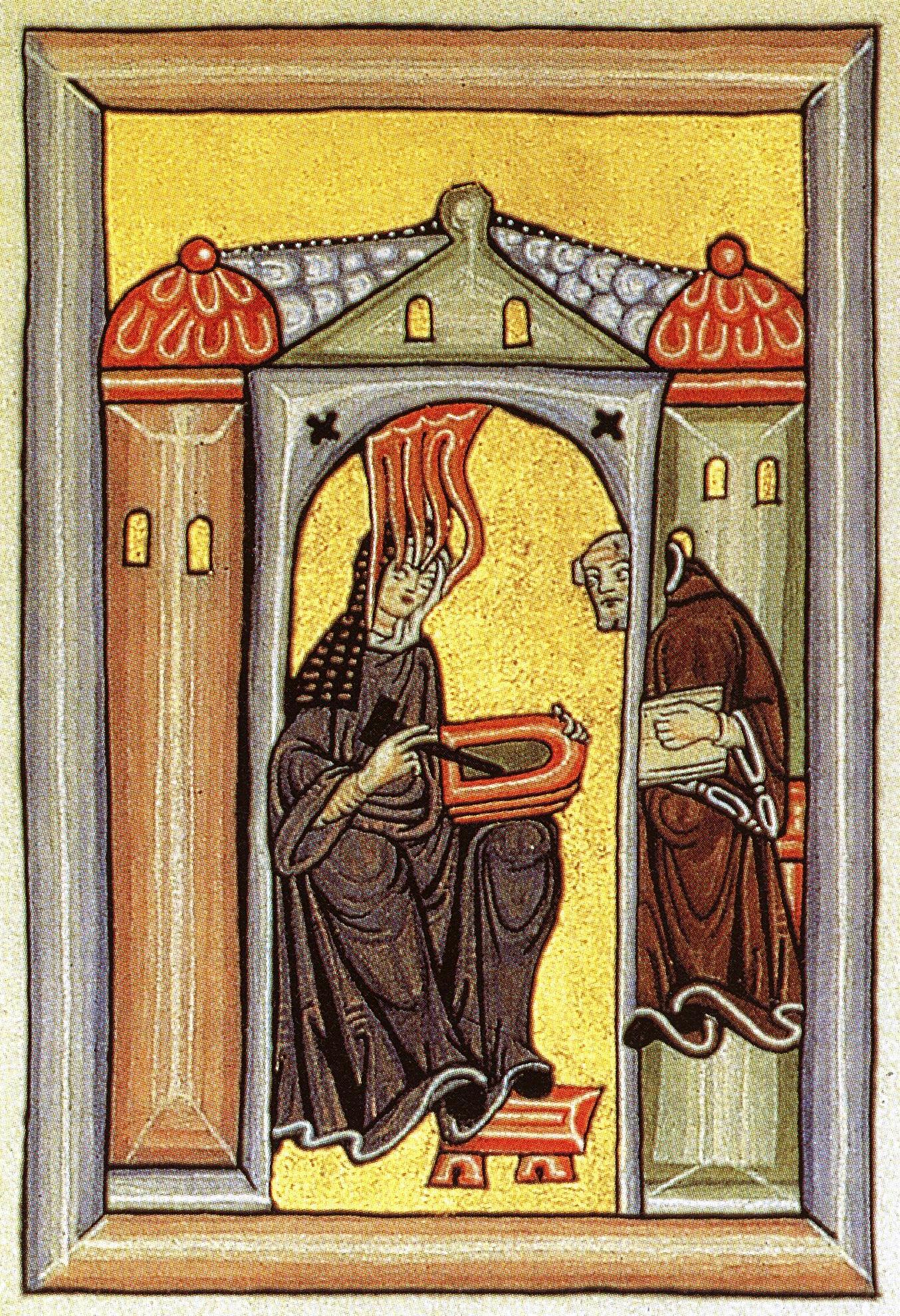
Catherine of Siena (Benincasa) b. Siena, 1347; d. Rome, 1380.
Mystic and Church reformer, canonized in 1461. Joined the Dominican tertiaries at age seventeen, living a life of extreme asceticism and serving the poor and sick. Entered the political sphere in her last decade, actively campaigning for Church reform and an end to the papal schism. Extensive correspondence from this period survives (ed. Misciattelli and Tommaseo 1913–22; tr. Noffke, 2000–). Her most important work, based on her mystical experiences, is the Libro della divina dottrina or Dialog (ed. Fiorilli and Caramella 1928; tr. Noffke 1980). Raymond of Capua, a devoted disciple and later Dominican minister general, recounts her life in the Legenda maior (ed. Jungmayr 2004; tr. Kearns 1980).
Secondary sources. Luongo, Saintly Politics (2006); Undset, Catherine of Siena (1954)
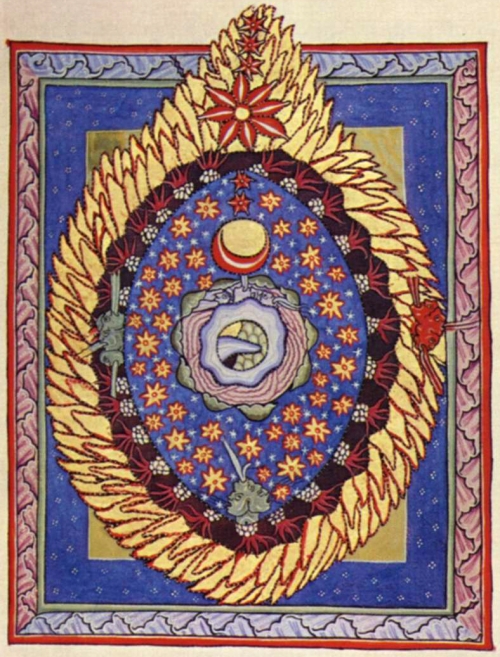
Gertrude the Great (of Helfta) b. 1256; d. 1302.
An orphan, raised from the age of five at the monastery of Helfta (Saxony), Gertrude was educated by Mechthild of Hackeborn, where she in turn became a spiritual counselor and educator. Her numerous spiritual visions are described in two works: the Exercitia spiritualia (tr. Lewis and Lewis 1989) and the Legatus divinae pietatis (Herald of Divine Love) (tr. Windworth 1993), much of which was compiled after her death (both ed. and [Fr] tr. Hourlier et al. 1967–86).
Secondary sources. Finnegan, Women of Helfta (1991); Bynum, Jesus as Mother (1982).
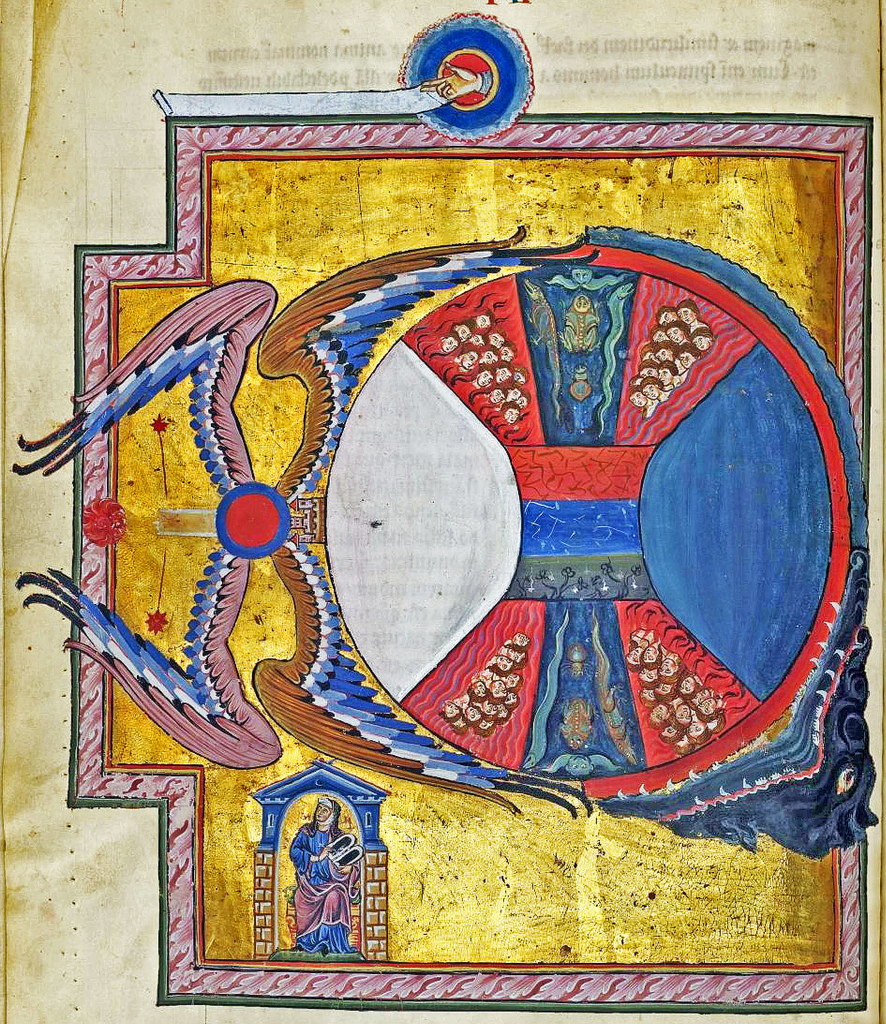
Hadewijch of Brabant b. Belgium, early 1200s; d. 1248, Antwerp.
Although little is known of her life, the beguine Hadewijch is known as the most famous of the 'love' mystics and was especially influential on Jan VanRuusbroec. At some point in charge of overseeing other beguines, Hadewijch wrote poetry and letters of instructions as well as recording her visions. An English translation of her Complete Works is available (tr. Columba Hart, 1980). Her high standards for spiritual and mystical life may have led to her alienation from her community prior to her death.
Secondary sources. McGinn, Meister Eckhart and the Beguine Mystics (1994); Grundmann, Religious Movements in the Middle Ages (1995).
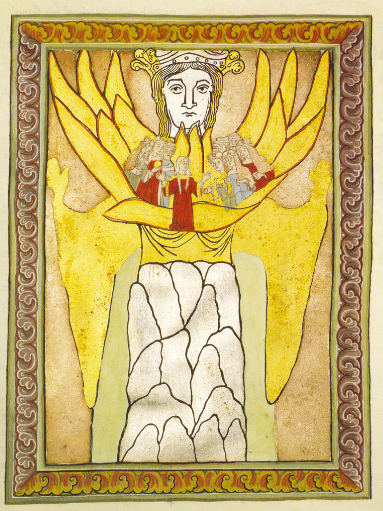
Hildegard of Bingen b. Bermersheim (Germany), 1098; d. near Bingen, 1179.
Benedictine nun and influential abbess, renowned for her mystical visions and for her theological, scientific, political, and musical contributions. Entered a hermitage at the age of eight, and a Benedictine convent at fourteen. Beginning in the 1140s, she became an influential public figure, completing four preaching tours throughout Germany and engaging in extensive correspondence with religious and political leaders across Europe – unprecedented roles at the time for a woman. Founded her own convent at Rupertsberg, near Bingen ca. 1150. She wrote three major works that describe her mystical visions (which she began having at the age of five) in detail and present allegorical commentaries on them--the Scivias [1141–51] (tr. Hart and Bishop 1990); Liber vitae meritorum [1158–63] (tr. Hozeski 1994); Liber divinorum operum [1163–73] (part. tr. Cunningham and Fox 1987).
All three of these works are edited in the Corpus Christianorum, as is a contemporary biography by Godefridus and others (ed. Klaes 1993; tr. McGrath and Palmquist 1995) and her extensive letters (tr. Baird and Ehrman 1994–), which are often of philosophical interest. Also authored two scientific/medical treatises, Physica (ed. PL 197; tr. Throop 1998) and Causae et curae (ed. Moulinier and Berndt 2003; part. tr. Berger 1999) [both 1150–60], as well as numerous poems and hymns, some of which Hildegard set to music.
Many popular treatments of her life and work are available, as well as scholarly treatments, such as Newman, Sister of Wisdom (1987); Newman (ed.). Voice of the Living Light (1998).
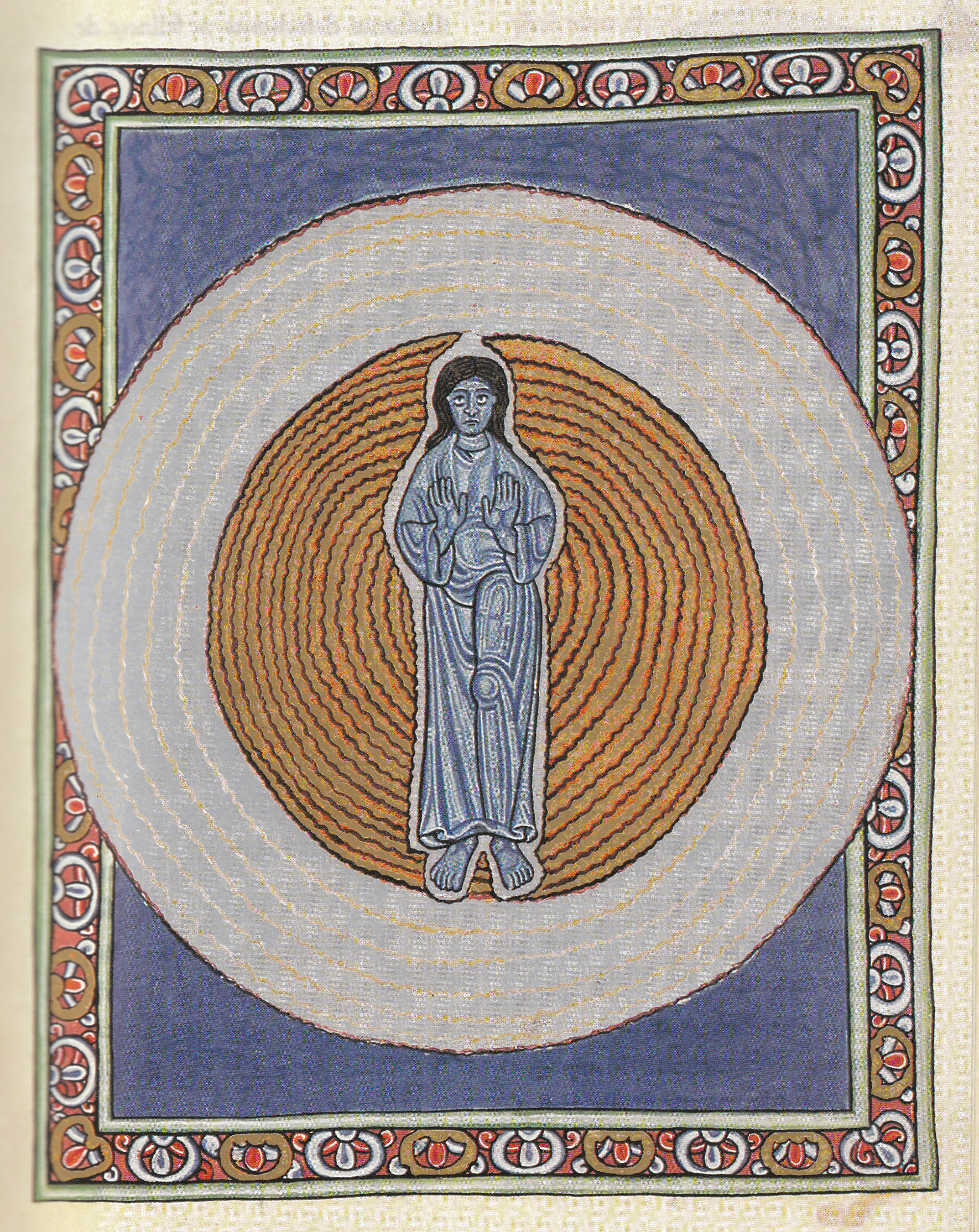
**Julian of Norwich **b. England, 1342; d. ca. 1416.
Anchoress and mystic, and perhaps a Benedictine nun. Almost nothing is known of her early life, but by 1394 she had chosen the solitary existence of an anchorite at St. Julian’s Church in Norwich. A series of sixteen visions during a grave illness at the age of thirty inspired her only work, the celebrated Revelations of Divine Love or Book of Showings (ed. [Middle English] Colledge and Walsh 1978; tr. [modern English] Colledge and Walsh 1978, etc.). The short version of this work [1373/93] confines itself to describing these mystical experiences; the long version [1393] interprets the original visions and describes the mystical experiences that had been continuous for the following twenty years.
Secondary sources. Jantzen, Julian of Norwich (1987); Upjohn, In Search (1989).
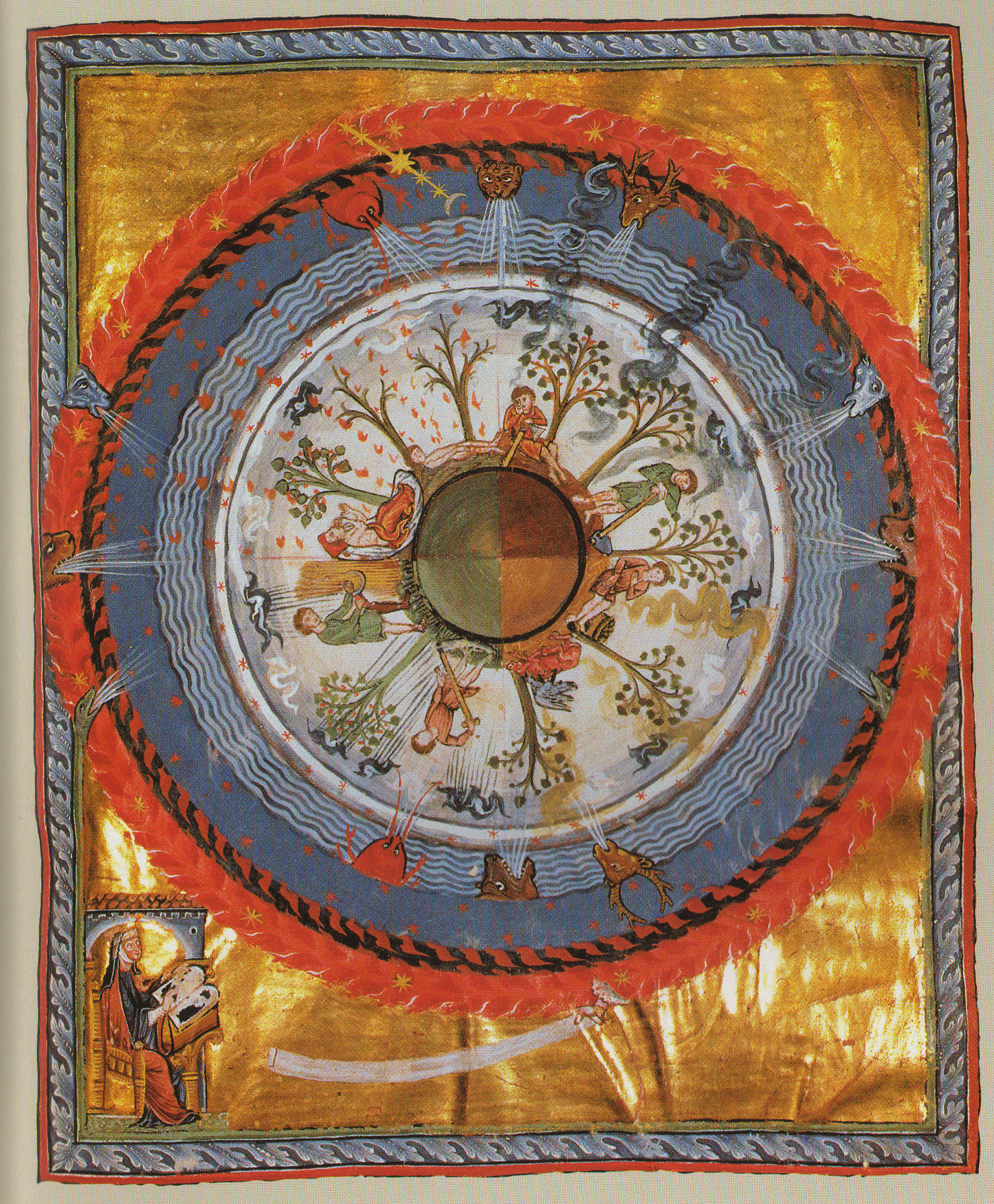
Marguerite of Porete b. ca. 1250; d. Paris, 1310.
French mystic. Described as a beguine, she was living around Valencienne (Belgium) in the early 1300s, when her book, Le mirouer des simples ames aneanties [ca. 1300] (ed. Guarnieri 1986; tr. Colledge et al. 1999) was condemned and publicly burnt. Written in Old French, and extant in Latin translation as well, the book characterizes the final goal of human life as a single, simple unitive act of will with God. It was subsequently enlarged, clarified, and eventually approved by a commission of theologians, but her repeated refusal to submit to ecclesiastical authority led her to be condemned as an unrepentant heretic, and she was burned at the stake.
Secondary sources. Hollywood, Soul as Virgin Wife (1995); Leicht, Marguerite Porete (1999); McGinn, Flowering of Mysticism (1998), Meister Eckart (1994); Petroff, Body and Soul (1994); Richir, Marguerite Porete (2002).
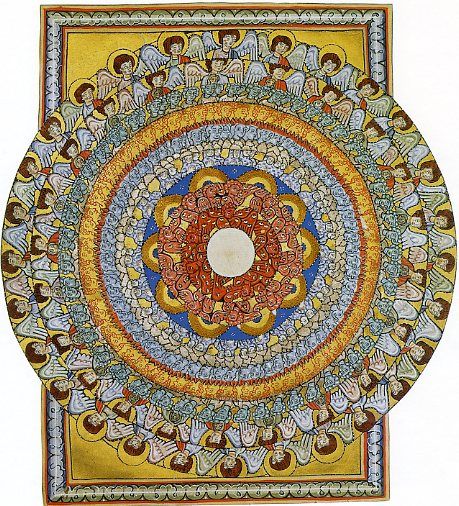
Mechtild of Hackeborn b. Helfta (Saxony), 1241; d. Helfta, 1299.
Cistercian (or possibly Benedictine) nun and mystic. Born into an aristocratic family, Mechtild entered the monastery of Helfta at age seven, where her sister Gertrude (not to be confused with the slightly younger Gertrude the Great) would become famous as abbess. Eventually put in charge of the monastery school, she counted Gertrude the Great among her students. In her last years she began to speak about the visions she had had from an early age. The Liber specials gratiae [1292–] (ed. 1877) is the record of these accounts, written down by two nuns, one of whom was likely Gertrude the Great. Although her work never received the attention of the 'other' Mechtild (of Magdeburg), many vernacular translations of her visions are extant (including one in Middle English, ed. Halligan 1979).
Secondary sources: Finnegan, Women of Helfta (1991); Bynum, Jesus as Mother (1982).

Mechtild of Magdeburg b. Saxony, 1209; d. Helfta, 1282/4.
Mystic, controversial ecclesiastical critic, and poet. Took up the life of a beguine in Magdeburg (Saxony) at around the age of twenty-three, under Dominican direction. Her life of prayer and asceticism was combined with an outspoken criticism of Church abuses, which led to her ongoing persecution. Eventually she sought refuge in the Cistercian (or possibly Benedictine) convent at Helfta in 1270, where she joined other renowned figures such as Gertrude the Great and Mechtild of Hackeborn. The work for which she is famous is The Flowing Light of the Godhead, which stresses the soul’s role as the bride of Christ; although originally written in Middle Low German, it survives only in Middle High German (ed. Vollmann-Profe 2003; tr. Tobin 1998) and Latin translation (minus the seventh book).
Secondary sources. Finnegan, Women of Helfta (1991); Hollywood, Soul as Virgin Wife (1995); McGinn, Meister Eckart (1994); Bynum, Jesus as Mother (1982).
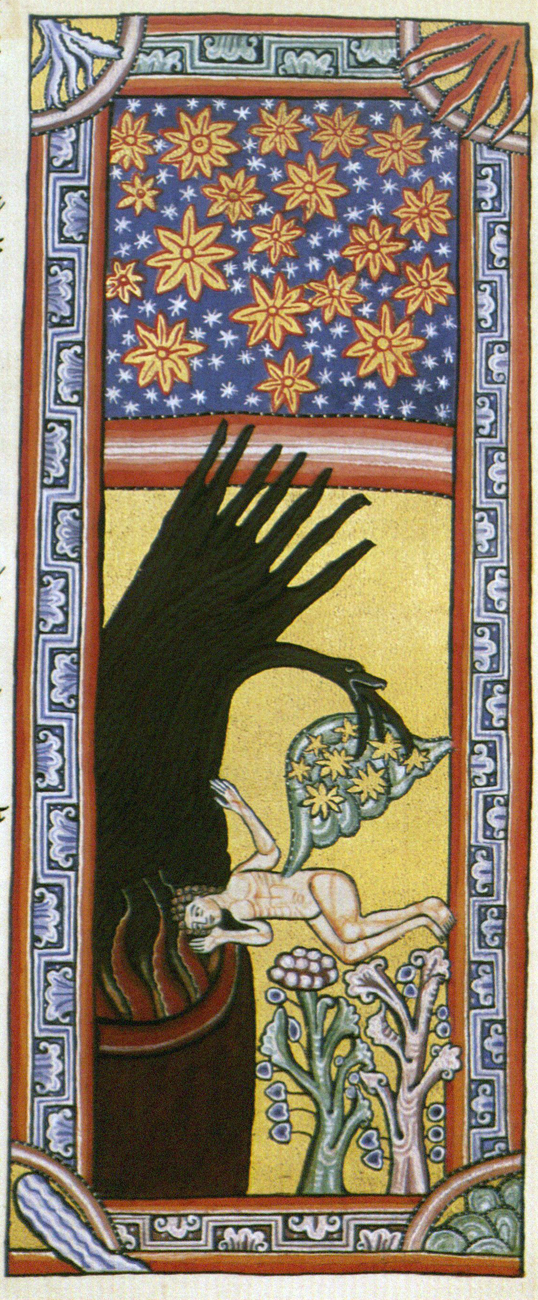
Bibliography of Secondary Sources
(Y'all get to look up the primary sources on your own; this post is already way too long!)
Beckwith, Sarah. Christ’s Body: Identity, Culture, and Society in Late Medieval Writings (London: Routledge, 1993).
Bynum, Caroline Walker. Jesus as Mother: Studies in the Spirituality of the High Middle Ages (Berkeley: University of California Press, 1982).
______. Holy Feast and Holy Fast: The Religious Significance of Food to Medieval Women (Berkeley: University of California Press, 1987).
______. Fragmentation and Redemption: Essays on Gender and the Human Body in Medieval Religion (New York: Zone Books, 1992).
______. Wonderful Blood: Theology and Practice in Late Medieval Northern Germany and Beyond (Philadelphia: University of Pennsylvania Press, 2007).
Finnegan, Mary. The Women of Helfta: Scholars and Mystics (Athens: University of Georgia Press, 1991).
Grundmann, Herbert. Religious Movements in the Middle Ages: The Historical Links between Heresy, the Mendicant Orders, and the Women’s Religious Movement in the Twelfth and Thirteenth Century, with the Historical Foundations of German Mysticism (Notre Dame, IN: University of Notre Dame Press, 1995 [orig. publ. in German, 1935]).
Hollywood, Amy. The Soul as Virgin Wife: Mechtild of Magdeburg, Marguerite Porete, and Meister Eckhart (Notre Dame, IN: University of Notre Dame Press, 1995).
Jantzen, Grace. Julian of Norwich: Mystic and Theologian (London: Paulist Press, 1987).
Leicht, Irene, Marguerite Porete: eine fromme Intellektuelle und die Inquisition (Freiburg: Herder, 1999).
Luongo, F. Thomas. The Saintly Politics of Catherine of Siena (Ithaca, NY: Cornell University Press, 2006).
McGinn, Bernard. The Presence of God: A History of Western Christian Mysticism (New York: Crossroad, 2005).
______. Meister Eckhart and the Beguine Mystics: Hadwijch of Brabant, Mechtild of Magdeburg, and Marguerite of Porete (New York: Continuum, 1994).
Mooney, Caroline (ed.). Gendered Voices: Medieval Saints and their Interpreters (Philadelphia: University of Pennsylvania Press, 1999).
Newman, Barabara. God and the Goddesses: Vision, Poetry, and Belief in the Middle Ages (Philadelphia: University of Pennsylvania Press, 2003).
______. From Virile Woman to Woman Christ: Studies in Medieval Religion and Literature (Philadelphia: University
of Pennsylvania Press, 1995).
______. Sister of Wisdom, St. Hildegard’s Theology of the Feminine (Berkeley: University of California
Press, 1987).
_______(ed.). Voice of the Living Light: Hildegard of Bingen and her World (Berkeley: University of California Press, 1998).
Petroff, Elizabeth. Body and Soul: Essays on Medieval Women and Mysticism (New York: Oxford University Press, 1994).
Turner, Denys. The Darkness of God: Negativity in Christian Mysticism (Cambridge: Cambridge University Press, 1995).
Underhill, Evelyn. The Essentials of Mysticism and Other Essays (New York: Dutton, 1920).
Undset, Sigrid. Catherine of Siena (New York: Sheed and Ward, 1954).
Upjohn, Sheila. In Search of Julian of Norwich (Darton, Longman and Todd, 1989).
Watson, Nicholas. “Middle English Mystics,” in D. Wallace (ed.) The Cambridge History of Medieval English Literature (Cambridge: Cambridge University Press, 1999) 539–65.
